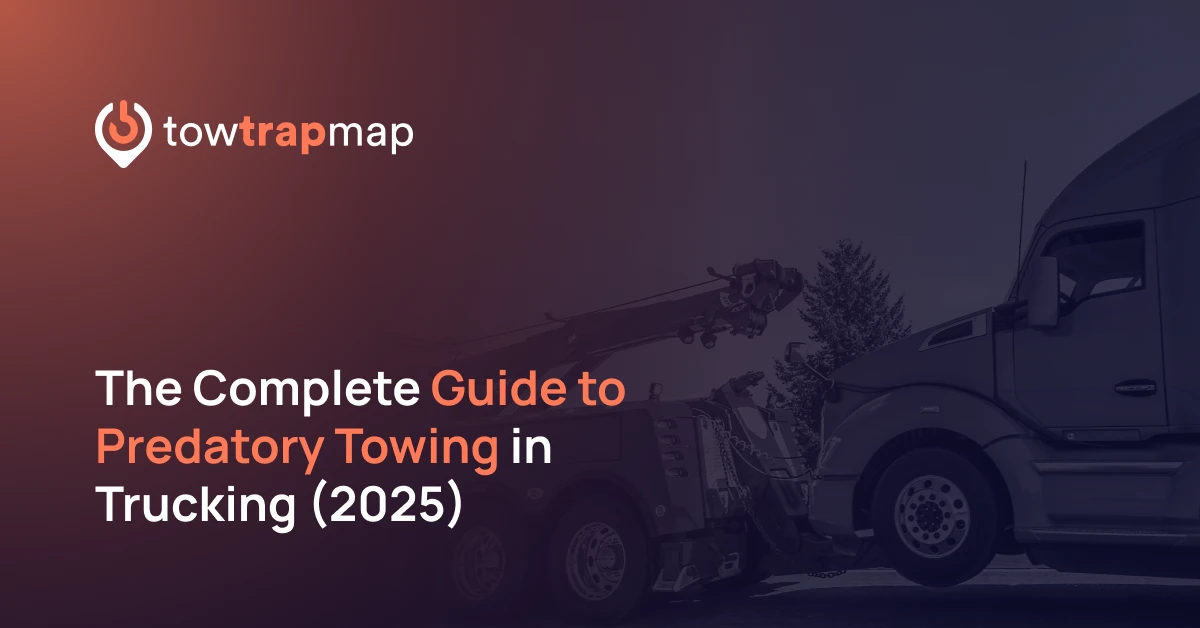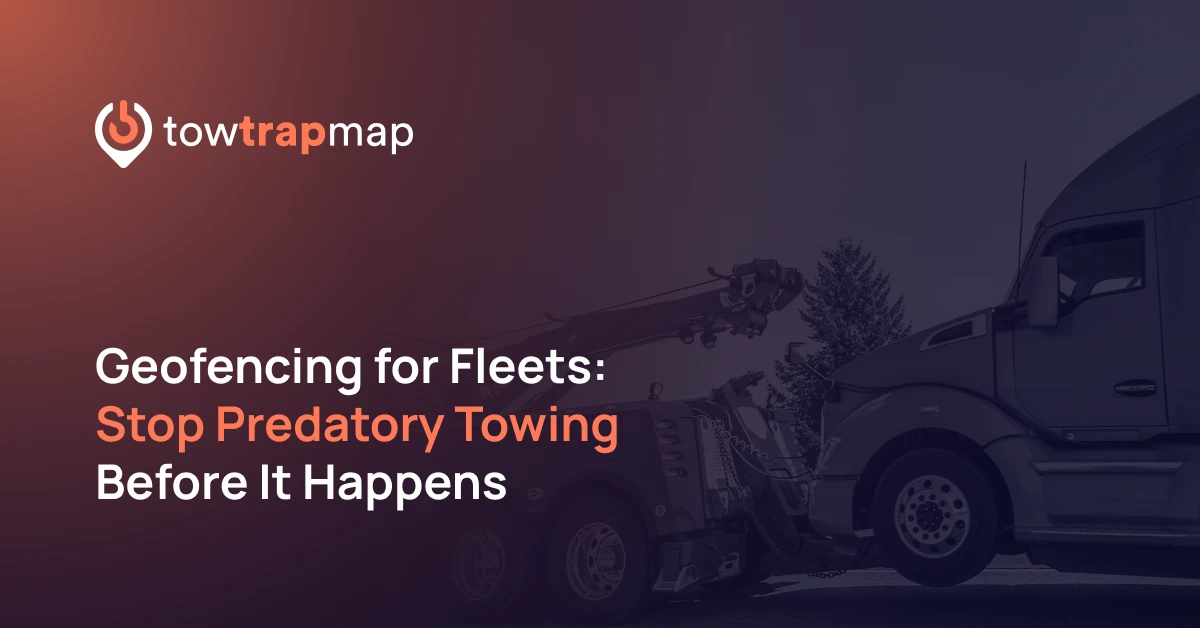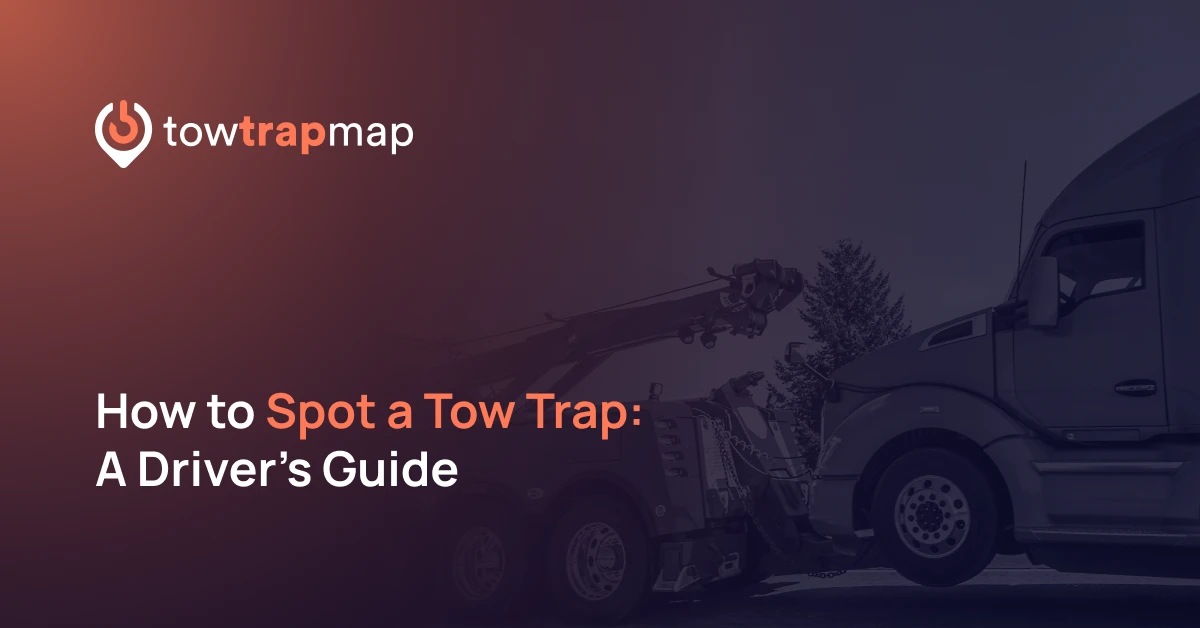Introduction – Why Predatory Towing Is a Growing Threat
Predatory towing has become one of the most frustrating—and expensive—problems in the trucking industry. Unlike legitimate towing, which serves a safety or legal purpose, predatory towing is designed primarily for profit.
For truck drivers, this can mean returning from a rest break to find a rig gone, and a $6,000 bill waiting at a tow yard miles away. For fleets, the costs go far beyond the invoice—downtime, lost loads, frustrated drivers, and even higher insurance premiums.
Across the U.S. and Canada, predatory towing has grown into a multimillion-dollar problem, targeting both individual drivers and entire fleets. This guide explains:
What predatory towing really is.
Why truckers and fleets are especially at risk.
The most common tactics towers use.
The hotspot cities where it happens most.
How technology like geofencing can prevent losses.
Why crowdsourced reports are the industry’s best defense.
Predatory towing happens when a truck is removed primarily for profit, not for safety, traffic flow, or law enforcement.
Legitimate towing: A semi parked in a fire lane, blocking emergency access, or left in a hazardous spot.
Predatory towing: Hidden or confusing signage, vague “authorized only” rules, or lots where truckers are almost guaranteed to get towed.
The difference lies in intent. In a predatory tow, the conditions are engineered to trap drivers, not protect the public.
Example: In Los Angeles, a driver parked for less than 15 minutes outside a distribution center. Even though no signs were visible from the cab, his truck was hooked and removed, resulting in a $7,000 release fee.
Predatory towing thrives because drivers have limited parking options and almost no negotiating power once their rig is towed.
Trucking is particularly vulnerable to predatory towing because of structural challenges:
Severe parking shortage: Across North America, drivers can’t find enough safe, legal spaces. When hours-of-service rules hit, they often have no choice but to risk questionable lots.
High-value vehicles: A tractor-trailer is worth towing. Release fees for heavy-duty trucks easily reach $5,000–$9,000.
Concentrated traffic: Fleets frequent the same ports, warehouses, and industrial zones—prime territory for predatory towers.
Patchwork regulation: Some states or provinces have rules, but enforcement is weak or inconsistent. In many areas, towers operate unchecked.
For fleets with 50–100 trucks, just 2–3 incidents per year can wipe out six figures in profit margins.
Predatory towing companies rely on a handful of proven tactics. Each one is designed to make drivers fail before they even realize what’s happening.
Hidden or Confusing Signage
Signs may be:
Placed too high to read from the cab.
Hidden behind trees, poles, or buildings.
Written in small print no driver will notice after 12 hours on the road.
These signs often say things like “Authorized Vehicles Only” but never define who qualifies—making it easy to tow anyone.
Rapid Patrols and Spotters
In hotspot areas, tow trucks circle lots like vultures. Some companies hire “spotters” to call the moment a truck parks. Drivers have reported rigs being hooked in under 10 minutes.
Excessive and Invented Fees
Invoices include:
Hook-up/tow fees: $1,500–$3,000.
Storage: $200–$300/day.
“Gate” or “release” fees: $500 or more.
Inflated mileage: $5–10 per mile, even for a 2-mile tow.
The final bill often exceeds $6,000–$9,000—well beyond regulated rates.
Cash-Only Payments
Some yards refuse credit cards or wire transfers, forcing fleets to scramble for cash. This delays recovery and adds hotel, layover, and rescheduling costs.
Remote Tow Yards
Many trucks are taken far outside urban centers, adding hours of downtime just to retrieve equipment.
Together, these tactics create a system where drivers always lose—and towers always profit.
Predatory towing doesn’t happen evenly—it concentrates where trucking is most active.
U.S. Hotspots
Chicago, IL: Private lots near industrial corridors; fleets report multiple tows per month.
Houston, TX: Hidden signs around warehouses; trucks towed within minutes.
Los Angeles, CA: Parking scarcity near ports fuels constant complaints and lawsuits.
New York City, NY: Unclear rules, aggressive patrols, and stacked fees over $5,000.
Canadian Hotspots
Toronto, ON: Provincial rules exist, but fleets still report inflated charges and intimidation.
Vancouver, BC: Port and warehouse districts with rapid patrols.
Calgary & Edmonton, AB: Repeated cases of $5,000+ bills in industrial parks.
These regions are prime targets because of heavy freight traffic, weak enforcement, and desperate drivers needing rest.
The invoice is only the beginning. Fleets suffer both direct and indirect costs:
Direct Costs
Tow and hook-up: $1,500–$3,000.
Storage: $200–$300/day.
Release/admin fees: $500+.
Mileage charges: inflated and unavoidable.
Example: One mid-sized fleet was hit with two tows in a month—$6,000 and $9,000—totaling $15,000 in direct costs.
Indirect Costs
Lost loads: Missed deadlines cost contracts and penalties.
Driver downtime: Fleets still pay wages, hotels, and meals.
Dispatch disruption: Staff waste hours negotiating with tow yards.
Insurance risk: Frequent claims trigger higher premiums.
Driver morale: Frustrated drivers quit, costing fleets $5,000–$10,000 to replace.
On thin margins, a few predatory tows can turn profit into loss.
Laws and Regulations in 2025
Some regions have tried to crack down, but gaps remain:
United States: States like Texas and New York have caps, but enforcement is inconsistent. In Chicago, loopholes allow towers to continue aggressive practices.
Canada: Ontario requires licensing and rate caps, yet fleets still report inflated bills. Alberta and BC remain under pressure for reform.
The bottom line: laws are patchy and slow to adapt. Fleets can’t rely solely on regulation—they need proactive defenses.
How Drivers Can Protect Themselves
Always scan for signs at lot entrances and perimeters.
Avoid lots that are too empty in high-demand areas.
Look for idling tow trucks—it’s often a sign of active patrol.
Ask other drivers about local hotspots.
Report suspicious locations to TowTrapMap to warn others.
Every report adds another shield for the next driver.
Train drivers on common hotspot regions and signage patterns.
Maintain internal “do not park” lists by city/route.
Use mapping and geofencing tools to mark risky lots.
Integrate alerts into telematics (Samsara, Geotab, Motive).
TowTrapMap helps fleets by turning crowdsourced reports into verified polygons (GeoJSON/CSV) that can be imported directly into fleet systems.
The Power of Crowdsourcing
Predatory towing thrives in silence—drivers isolated, fleets unaware. Crowdsourcing flips the script.
Drivers and fleets submit reports at TowTrapMap.com/report.
Submissions are moderated for accuracy.
Verified locations appear as pins and geofenced zones.
Fleets export zones to telematics for real-time driver alerts.
Every new report makes the database stronger.
Conclusion & Call to Action
Predatory towing is one of the biggest hidden costs in trucking today. The tactics are subtle, the bills are crushing, and the ripple effects damage fleets and drivers alike.
But knowledge is power. By reporting tow traps, sharing experiences, and leveraging technology, truckers can protect themselves—and each other.
👉 Have you seen a tow trap? Submit your report today → TowTrapMap.com/report
Because every report protects the next driver. 🚛



